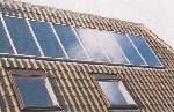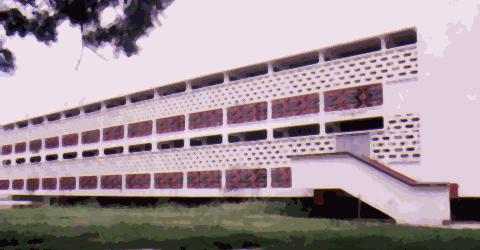Chapter 6: Our solution
This chapter is about what kind
of energy source we have chosen for the school in Ghana.
The energy sources we have been thinking of are:
-hydro-electric power
-biogas
-solar power
-wind energy.
We chose two things, hydro-electric power and solar power.
Why have we chosen this?
Because they already have hydro-electric power. Nothing wrong with that. But
that may be not enough in the future.
We have chosen solar panels and solar collectors, because there are 2372.5 sun
hours a year, that means that there are 6,5 hours a day. We've also chosen to
produce half of the now used amount of electricity because they probably don't
have enough space on their roofs for enough solar panels to produce the total
amount.
The lighting mains gives hydro-electric power and can be
used to take from when there is more needed than can be
produced by the solar panels. It is also a buffer to deliver
to, when more is produced than is needed at the moment.
This way no storage is needed, such as batteries. The
installation in a simplified diagram:

The gas consumption should be reduced as much as possible. The gas is used to
warm water and for cooking. A part could be replaced by solar collectors to
make warm water. It doesn't need to be heated as much as cold water and saving
electricity. Cooking can be done with electric stoves, which use approximately
3 kW each.
Why didn't we choose the other energy sources?
- We didn't choose biogas, because they have a farm, but the amount of organic
is far too less to support energy for the whole school.
- We didn't choose wind-energy, because it is visual pollution and it is more
expensive than Solar energy.
These are the calculations we made:
Half of the present electricity consumption
The electricity used is app. 18000 kWh per term.
A term is about 100 days. That means an average consumption of 180 kWh a day.
If there are 10 hours of sunshine a day as an average throughout the year, the
average needed power is 18 kW.
The gas and wood consumption
We have assumed that:
1 m3 LPG gas is 800 kg.
LPG gas produces 5000 kWh per m3.
The used amount of wood is ╝ of the gas consumption (in kg).
Then a gas consumption of 3750 kg + the wood will be in the future as equal as
1.25 x 4000 = 5000 kg of LPG gas, = 5000/800 m3.
That gives an energy of (5000/800)x5000 kWh per term.
This is per hour (1000 production hours per term): 25000/800 = 31 kW.
If we would produce all electricity, we should need 18 + 31 = 49 kW.
Now we choose for the half: 20 kW installed electric power by solar panels.
The other 19 kW will be taken from the mains and produced by solar collectors.
The solar collectors.

We could not find the properties of solar collectors in time. But we think
that it is possible to install enough solar collectors to produce enough warm
water for cooking, washing and showers.
We also expect that there is room enough on the roof of the kitchen building
to place them .
The solar panels

We are going to use
Kyosera KC120 solar panels, they can deliver 120 W and cost $585,- per panel.
A power capacity of 20 kW can be achieved by
20,000/120 = 167 panels. Several buildings must be covered by those panels, we
suppose.
Without the invertors and the rest of the installation that will cost app.
$100,000! So about 250,000 guilders. Wow!! Isn't that too much?

Delivering energy to the lighting mains
The solar cells can produce a lot of energy, if the sun is shining. A day one
solar panel produces about 1.2 kWh.
If they don't use all the energy that the solar cells produce, it is possible
to sell the energy which is too much to the (lighting) mains or to other
households.
In this way you can earn some extra money and it is ecologically sound.
If they use more energy than the solar cells produce, they can use the
electricity of the lighting mains. The electricity of the mains is
hydroelectric, so also renewable energy.
But to do this, a conversion unit is needed. Solar cells produce DC (Direct
Current), but only a few devices can work on DC. Most devices need AC (Alternating
Current). E.g.: Lamps only work on AC.
So if they want to use the energy from the solar cells, a inversion unit is
needed. The inversion unit will convert DC into AC.
In the invertor a counter is working. If they use energy from the (lighting)
main, the number on the counter will increase. If they have too much energy,
they can give some to the mains. The counter will go back. So they can
cooperate with the mains. That will be a great advantage for both.
We mentioned before that it is also a great advantage that the mains can be
used as a kind of storage buffer.
Copyrightę2000-2001 Ga2tMarnix



